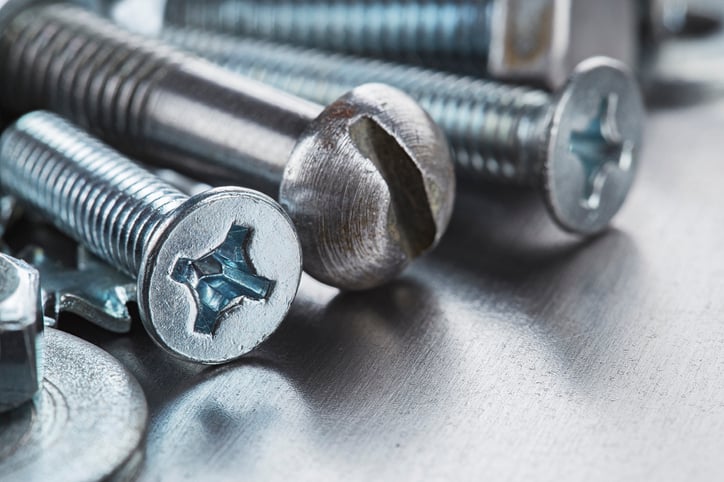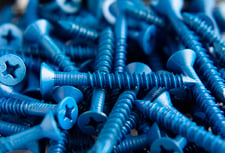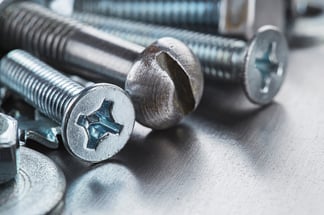How To Cut Threaded Bolts
You don’t have to know how to cut threaded bolts when working on a project, but it often helps to know someone who can.

Are the threads rolled or cut? This is a common question that’s asked, especially when an engineer or purchasing manager is wondering how some bolts are manufactured. Although the process always starts with a smooth, steel rod…the threading formed in cutting and rolling is slightly different.
Thread rolling and thread cutting (as it is also called) are necessary to ensure fastening. Your preferred method may come down to the specific project that you’re working on.
Roll-threading is a cold-forming process that utilizes hardened steel to form threads on a bolt. Roll-threading bolts are made to roll the threads. The steel die has a shape similar to the threads being rolled. The die is placed over the set of hardened steel dies to form threads onto the rod. 
As the bolt is put under high pressure, the grain steel is made to roll in multiple directions forming threads on the bolt. This process doesn't interrupt the structural composition of the bolt — it creates a more precise thread because it does not leave any tool marks on the steel dies. In addition, rolled threads are smooth in installation and significantly resistant to damage due to the hardening and compression during threading.
Cut threading involves a process by which steel is physically removed or cut away from a round steel rod to create threads. The process uses a cutting tool shaped like the threads being cut. The manufacturer then places the cutting tool over the workpiece and cuts into it. The process leaves tool marks on the workpiece, but it is more precise than the thread rolling process because it is easier to create threads of any diameter needed.
The main differences between roll threading versus cut-threading bolts are argued in terms of cost of manufacturing, waste on the materials, and the efficiency in manufacturing desired bolt diameters. 
On the one hand, thread rolling bolts have more efficiency in strength and cost of manufacturing. The process only requires subjecting steel dies to pressure. The bolt is further compressed, strengthening its structure — the rod doesn't wear out during the process. In addition, the process is cost-effective in producing strong bolts.
On the other hand, thread cutting involves removing some materials from the rod to form the threads. While this process is presumed to weaken the bolt, it's more effective in manufacturing screws of different specifications, including those of larger diameters.
The cut-threading process leaves tiny tears on the screw. If you critically analyze screws made by roll threading versus those made by cut threading, you may notice tiny tear marks on the cut-thread screw. The manufacturing process tears the material on the rod, leaving a set of tear marks that run perpendicular to the direction of the thread. The minor fractures in the cutting process can wear faster, affecting the screw's stability.
The roll threading process deforms and cold works the rod, pressing it further to strengthen its resilience. This process doesn't leave tears that may lead to cracks over time.
Another significant difference between roll-threading versus cut threading screws involves the screws' diameter. Roll-threaded screws have smaller structures than cut-threaded screws. Due to compression, the rolled threading reduces the fastener's body substantially. For instance, when roll threading a one-inch diameter rod, the fastener body will reduce to 0.912 and one-inch threading after roll threading.
Nonetheless, the cut threading process produces a full one-inch diameter screw and the same one-diameter threading. Some engineers claim that cut threading bolts are stronger than roll threading ones. This is because the strength of a screw depends on its thread rather than body size.
Understanding the major differences between roll threading and cut threading screws can help you find the fastener that’s best for your project. The purpose of the screws you’re looking for will most likely determine if roll threading or cut threading is what you need. While there's a debate about which threading is stronger, both will serve their purpose.
Consulting a professional can help you determine which screws are right for your needs. At Big Bolt, we thrive on making quality fasteners quickly. We believe customers should never sacrifice quality when it comes to fasteners.
So, if you're a distributor, purchasing manager, or design engineer, professionals at Big Bolt can help you obtain nothing but high-quality fasteners. Contact us if you have any questions.
You don’t have to know how to cut threaded bolts when working on a project, but it often helps to know someone who can.
You don’t have to know how to cut threaded bolts when working on a project, but it often helps to know someone who can.
You don’t have to know how to cut threaded bolts when working on a project, but it often helps to know someone who can.